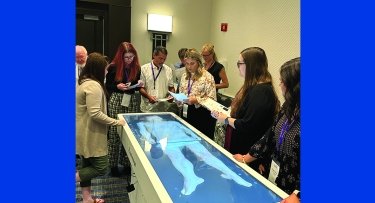Mercy Faculty Showcase Innovative Curriculum at Anatomage Conference

“The Anatomage Table is an important piece of the puzzle,” said Bireline. “It allows students to touch, feel, and experience a digital human cadaver and understand how things really look in the human body.”
Mercy University faculty members Fenn Esser, Ph.D., assistant professor of health sciences, and Amanda Bireline, assistant professor of health sciences, presented at the national Anatomage 2023 Conference, which took place in Santa Clara, California. They led workshops on applying evidence-based teaching tools using Anatomage Tables, which display a life-size human cadaver on what resembles an operating table. The tables enable students to visualize, manipulate and dissect the human body virtually. Hosted by Anatomage, the conference drew approximately 150 attendees, including instructors at high schools, undergraduate and graduate programs, and medical schools.
Bireline and Esser shared how they have used the Anatomage Table to create an inclusive lab experience in the course “Human Anatomy & Physiology I” (A&P I). The course invites all students to engage in the content — regardless of their background, level of education, or level of experience with anatomy and physiology. Their workshops gave participants a look into Mercy’s curriculum by incorporating two activity stations with accompanying worksheets and a clinical case study that Mercy students engage in.
“The Anatomage Table is an important piece of the puzzle,” said Bireline. “It allows students to touch, feel, and experience a digital human cadaver and understand how things really look in the human body.”
Mercy’s A&P curriculum prioritizes hands-on learning. Students rotate through lab stations as they engage in interactive group work and grapple with inquiry-based questions. Over the course of each semester, they work through several clinical case studies that prompt them to apply their knowledge to real-life situations. All the while, peer mentors support students’ learning and build camaraderie while developing their own leadership skills.
A significant redesign of Mercy’s A&P I curriculum began in 2019 to increase learning and improve student pass rates. These efforts worked remarkably well. Between the fall 2019 and fall 2022 semesters, Mercy’s A&P I pass rate for white students increased from 73% to 88%, and the pass rate for Hispanic students increased from 57% to 91%. These results are particularly significant because A&P I is a gateway course, meaning that all health sciences majors must pass it to progress with their degree.
The redesign efforts were supported by the generous donation of an Anatomage Table in 2017 by Gioietta and Alberto Vitale, H.D. ’09, and by a $3 million grant from the U.S. Department of Education under the Title V Developing Hispanic Serving Institutions program. The grant allowed Mercy to purchase four more Anatomage Tables in 2020.
The feedback on Bireline and Esser’s conference workshops was overwhelmingly positive. Attendees even asked to purchase Mercy’s lab manual and station materials. In addition, Anatomage asked Bireline and Fenn to share their materials with the company’s online community.
“It was truly a conference focused on learning,” said Bireline. “Mercy’s A&P faculty team and especially Fenn have worked tirelessly to improve the curriculum and the lab experience. But there’s always room to grow, so we’ve brought back a few new ideas that we’re excited to implement this fall.”
